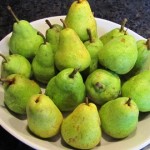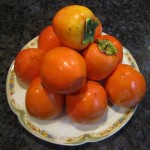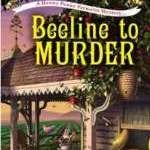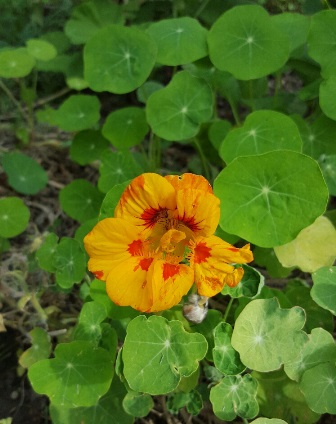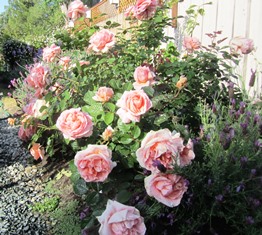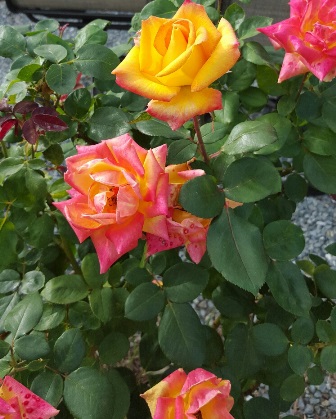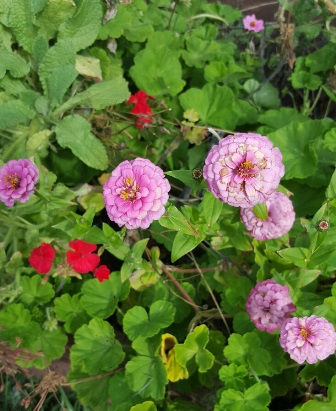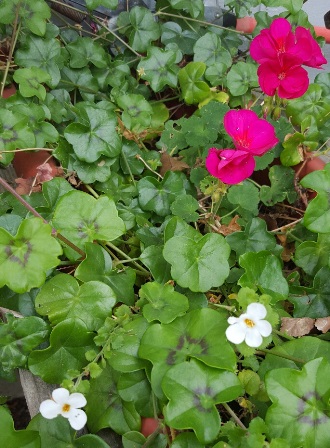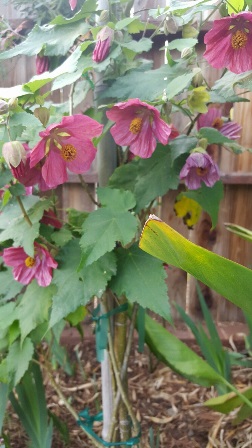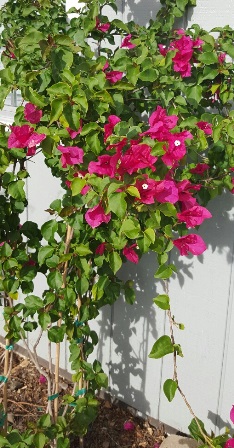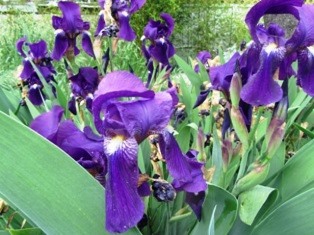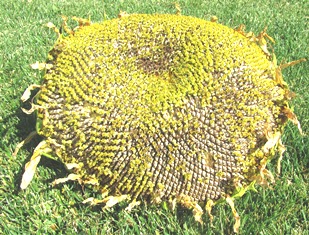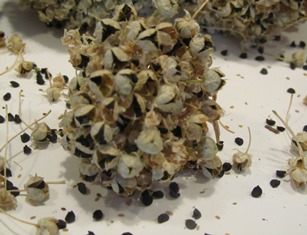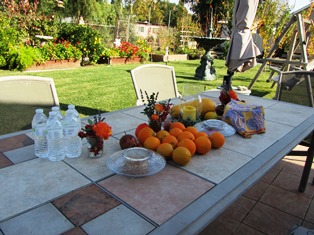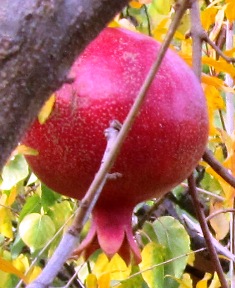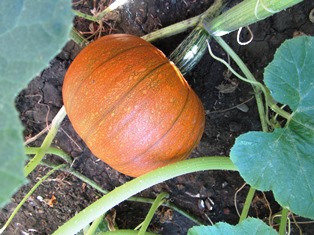Persimmon Trees Are Productive, Pretty, and Easy to Grow
The Japanese Hachiya persimmon is a small to medium-size tree that packs a lot into a landscape. In autumn, the tree’s large, leathery leaves turn orange, red, and yellow, reminiscent of the gorgeous fall colors of trees growing in the east and midwest. Of course, mine are growing on my farmette in Northern California.
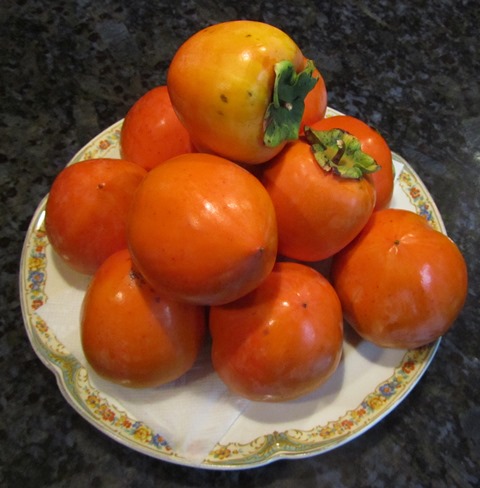
After a persimmon tree sheds its canopy of leaves, its scaffold continues to provide visual interest in the garden. Globes of orange fruit hang on for weeks, looking a lot like Christmas ornaments.
An easy way to eat a fresh Hachiya persimmon is to first wash the soft, ripe fruit. Then, slice off the top, scoop out the pulp with a teaspoon, and enjoy a mouthful of the flavorful fruit that resembles sweet pudding. A word of warning about biting into unripened fruit. It is extremely astringent and unpalatable.
Growing the Hachiya persimmon is relatively easy. These trees aren’t fussy about soil and don’t need a lot of watering. In dry climates, give the tree a weekly soaking during its growing season. Persimmons are relatively disease-free and don’t attract a lot of pests.
Train them to grow into a vase shape during the first three to five years. Be mindful that the fruit is produced on new wood. However, a severe pruning will reduce your fruit crop. Once the tree is established, do your pruning during the tree’s winter dormancy to remove dead and diseased branches or those that are crossing other branches.
If you enjoy reading about gardening and other country living topics and also enjoy a good cozy mystery, check out my Henny Penny Farmette series of novels. These novels also include wholesome recipes, tips for keeping chickens and bees, and gardening info based loosely on my experience as the real Henny Penny Farmette proprietress. The novels are available online and everywhere books are sold.
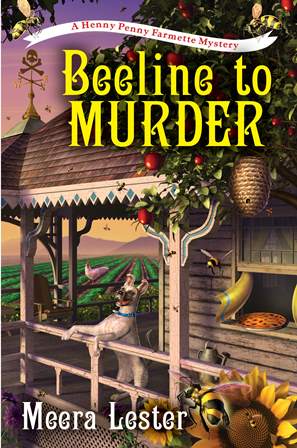
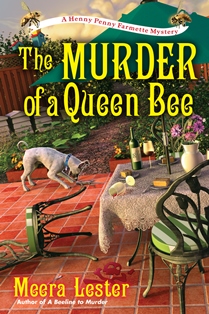
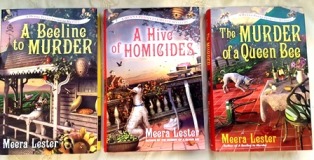
Available from the publisher, Kensington NY, Barnes and Noble, Amazon, and other online and traditional bookstores everywhere.
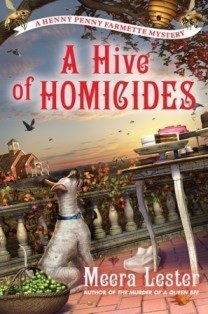
Enjoy reading about farm topics? Check out my Henny Penny Farmette series of cozy mysteries. Chocked full of farm trivia and helpful advice for keeping chickens and bees and growing heirloom fruit and vegetables, all three novels are available online and in bookstores everywhere.
Get the three-book series of cozy mysteries with elements based on the real Henny Penny Farmette
These novels include elements based on the real Henny Penny Farmette
A Beeline to Murder–When the town’s celebrity pastry chef is found dead, Abby Mackenzie (a former cop who supplies the chef with her organic lavender honey) discovers the chef’s secret private life suggests the killer might be local.
The Murder of a Queen Bee–The botanical shop owner and friend of Abby Mackenzie doesn’t make it to a party where she’s the guest of honor. Her death leads Abby to speculate that friends of the deceased might be hiding her killer.
A Hive of Homicides–Abby attends a vow-renewal party of her best friend and is an ear witness to the murder of the newly arrived re-married couple. The husband’s philandering past establishes a pool of suspects but Abby is convinced that there’s more to the murder a scorned lover’s revenge.
Baking with Persimmons
Fall is the time when persimmons come to market. In general, you’ll see two different types. Fuyu is a squat-shaped, round fruit. Hachiya has a pear shape. Both fruits possess a bright orange color, thin skin, and leaves at the bottom when ripe.
Fuyu can be consumed at the crunchy stage like sliced apples in salad but you must not eat hachiya until it is soft and fully ripe because of its extreme astringency. You can slice off the top of Hachiya and eat it with a spoon like a soft pudding.
Turn your ripe persimmons into pulp before making baked goods such as bread, cake, and bar cookies. Nothing says autumn like this late autumn fruit in a lemon-drizzled bar cookie that uses the pulp of persimmons and chopped dates. In the recipe that follows, I used the Sunsweet brand of chopped dates.

RECIPE for Persimmon-Date Bars with Lemon Glaze
Ingredients:
1 3/4 cups flour
1 teaspoon ground cinnamon
1 teaspoon ground nutmeg
1 teaspoon Kosher salt
1/2 teaspoon ground cloves
1 cup pureed persimmon pulp
1 1/2 teaspoon lemon juice (plus 2 tablespoons for glaze)
1 teaspoon baking soda
1 cup granulated sugar
1 cup finely chopped dates
1/2 cup vegetable oil
1 egg
1 cup confectioners’ sugar, sifted

Directions:
Preheat oven to 350 degrees Fahrenheit. Grease and flour a 9 x 13-inch glass baking dish.
Mix together flour, cinnamon, nutmeg, salt, and cloves in a bowl.
In a separate bowl, thoroughly combine persimmon pulp, 1 1⁄2 tsp. lemon juice, and baking soda. Set aside.
Using a whisk, mix together granulated sugar, dates, oil, and egg in a large bowl. Add dry ingredients and persimmon mixture. Stir until just combined and then pour mixture into the prepared baking dish. Use a spatula to flatten and smooth the top of the cookie dough.
Bake 25 minutes until lightly browned. Remove from oven and let cool for five minutes while you make the glaze.
To make the glaze, whisk together 2 tablespoons of lemon juice and confectioners’ sugar until smooth. Pour the glaze in zigzags across the bar cookie and then smooth out the glaze with a spatula. When the bar cookie has hardened, cut into rectangular bars or diamond shapes.
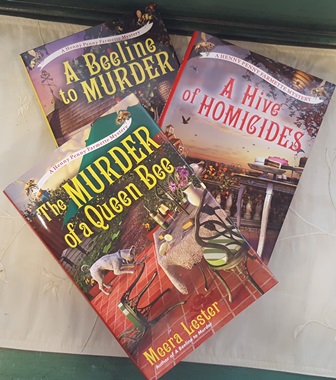
The Fall “P” Fruits Are Ripening on the Farmette
Our pears, persimmons, and pomegranates hang heavy on the trees now. This despite the scorching summer we’ve had and the lack of rain. Water restrictions have made it doubly difficult for the fruits of these trees to reach their full potential.
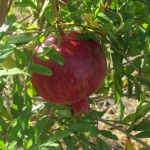
Ripe pomegranates have a leathery outer skin, membranes thicker than oranges, but sweet, juicy seeds inside
The squirrels and raccoons have been munching on the late summer pears. Yesterday, I stripped most of the fruit off and placed in paper bags in the kitchen cabinet. In two to three days, the pears will reach the perfect ripeness for eating fresh.
Fuju and hachiya persimmons are taking on color and should be ripe and ready to eat in about a month. I’ve been working hard to save the trees that are suffering from California’s extreme drought.
A spokesman for one Bay Area water resource board suggested we gardeners let our ornamental plants like roses and other flowers go while we try to save our trees. A hard thing for me to do. Praying for rain, we hold out hope that next year’s climate will be better for backyard gardeners and growers.
______________________________________________________________________________
Interested in backyard gardening topics like keeping chickens and bees or growing heirloom vegetables? Check out my cozy mystery series from Kensington. The stories are informed by my work on the farmette I’ve been restoring for a dozen years. Find all Meera Lester books on Amazon.com, Barnesandnoble.com, and everywhere books are sold online or in brick and mortar stores.
Beeline to Murder features a former cop who keeps bees
and sells lavender honey to her town’s celebrity chef . . . until
she finds him dead.

The town of Las Flores is abuzz with the news of the death of a free spirit who has secrets in her background and ties to a local nudist camp.

The renewal of wedding vows ends on the steps of the church with the outburst of a local woman intent on revenge. The husband is soon found dead but the obvious suspect may not be the culprit at all.
Seasonal Blooms for Floral Arrangements
Autumn in Northern California is one of my favorite times of the year. By November, many of the summer blooms in our flower beds have faded. Seeds have been collected for next year’s blooms. Now’s the time to put in bulbs and tubers for spring, but that doesn’t mean we have no blooms for a Thanksgiving floral arrangement.
The clocks have been turned back and the rainy season has arrived, but don’t tell that to the roses.
Red-gold roses, pyracantha berries, rustic seed pods, orange- and rust-colored zinnias, asters, willowleaf cotoneaster, and dahlias are some of the garden plants that combine beautifully in a fall floral arrangement. To the harvest table, I also like to add some seasonal fruits like pomegranates and persimmons.
Thanks to the recent rain, the bougainvillea blazes in shades of fuchsia, orange, red, and purple. Zinnia’s near the farmette’s bee house are still holding color and hanging on until cold weather arrives.
And while pyracantha (fire thorn) berries add splashes of bright orange to a dark corner of the garden where bamboo towers to ten feet, the Chinese lantern plant holds aloft dozens of small pink blooms like little lanterns.
With Thanksgiving three weeks away, I’m feeling confident that our table arrangement will include some of the season’s festive berries, seed pods, and blooming flowers collected from around the farmette.
In the meantime, I’ll notice the splashes of color to be discovered here and there and consider how to use them in a holiday bouquet.
* * *
NEWLY RELEASED–The Murder of a Queen Bee (Kensington Publishing, NY–Sept. 2016).
Discover delicious farm-to-table recipes, farming tips, and wisdom as well as sort out a charming whodunnit. Also, enjoy gardening tips and farm sayings. Dig for clues while learning about bees and chickens. To learn more, click on the link under the picture.
See, http://tinyurl.com/h4kou4g
See, http://tinyurl.com/hxy3s8q
This debut novel launched the Henny Penny Farmette series of mysteries and sold out its first press run. It’s now available in mass market paperback and other formats.
Gathering Seed for Next Year’s Garden
The sounds of summer around our farmette have grown quieter. It’s mid-August and the neighborhood children have returned to school. I miss their laughter. I miss the delight on their faces at seeing the chickens and the honeybees. I miss keeping them company at their lemonade stand.
But I admit to the secret pleasure of solitude and quiet, though it isn’t really silence. It’s the peaceful clucking of chickens and the twitter of songbirds as I gather seed from plants that have bloomed and dried, such as the cosmos, nasturtiums, sunflowers, and wisteria.
The wisteria vine that exploded in growth of long, green tendrils during spring and early summer and graced us with bracts of purple perfusion now hold heavy pods. The pods contain seeds that can be dried and planted for new vines next year.
The sword-shaped leaves of the irises are dry–their blooms a memory from early spring. I’ve already cut their long leaves back into four-inch fans and will dig some of the rhizomes for replanting in other beds around the farmette.
The sunflowers that the bees love to forage on have gone to seed. Those seeds will become next year’s plants, but some we’ll save for the squirrels.
The red and yellow onions have developed seed pods on long shoots now. I’ll plant those in raised beds in the fall for a spring crop of onions.
Yes, the dog days of summer have come around again. But the growing season continues. End of summer gives rise to autumn when grapes, persimmons, pumpkins, figs, and pomegranates ripen. On the farmette, there is always another season and other crops to look forward to with anticipation. It’s the good life.
A Roving Thanksgiving Starts with Snacks on the Farmette
The spontaneous invitation my husband made to friends to stop by for a Thanksgiving snack and beverage before the “real” meal started sent me scrambling. What was he thinking? We were celebrating with all the relatives at my daughter’s home, not ours, so how could I host a pre-party gathering? He assured me we could make it work if we kept it simple.
Our friends were scheduled to dine at a neighbor’s house in the late afternoon but decided they would come by our place first. I figured such a short visit of an hour or two wouldn’t require an elaborate meal . . . we would snack on crackers and goat cheese, drizzled in a sweet cranberry sauce; pumpkin cream cheese rolled in nuts; and a torte of goat cheese with a layer of pesto, sun-dried tomatoes, and finely chopped pieces of olive. We would offer bottled water, sparkling cider, and a wine to wash it down.
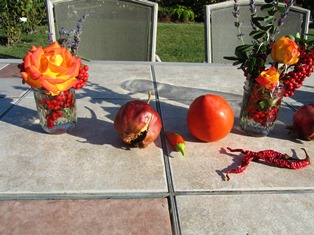
I gathered what was growing on the trees and in the garden to decorate an autumn harvest-looking table
Our Northern California weather could not have been lovelier, so I decided we would sit outside in our garden. I combined red pyracantha berries with blooming red-gold roses and some spikes of purple French lavender in jam jars for a harvest festival look on our patio table.
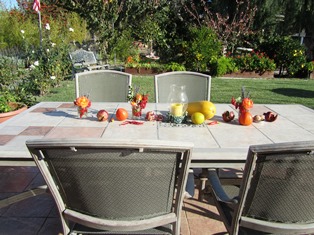
Decorations for the table began with a few pomegranates, persimmons, chilies, and onions–all readily available on the farmette
Our friends arrived and, after a short time in our tiny farmhouse, followed me to the garden. We had a lovely visit while the blue jays, crown sparrows, morning doves, and black phoebes entertained us with their antics. I think I enjoyed the day all the more for having a chance to socialize a bit in the garden before sitting down to the big feast with all the relatives. Next year, I might actually plan to do a roving Thanksgiving with several parties. It was so much fun!
Pomegranates and Persimmons Are Ripening Now
The pomegranates are turning from green to a deep red as they should be. It’s the middle of September after all. Some have split open, exposing the red seeds inside the fruits. My neighbor says it’s because of uneven watering. These trees don’t need much water and, I admit, I’ve been lax about running the hose on them.
The seeds are luscious, bursting with sweet-tart flavors. Eat the seeds raw or toss them into a citrus salad with fresh greens, oranges, sweet grapefruit sections, kiwi slices, tangerine sections, crunchy apple and pear slices, and sugared pecans.
While I wait for tomatoes (yes, an old heirloom variety of tomatoes with lots of vines that ripen late season) and the French pumpkins to ripen, I’ve noticed that the persimmons have turned a bright orange, but are still quite firm to the touch.
I planted hachyia persimmons instead of fuyu simply because I like them better. The fuyu persimmons are like small, flat apples. They are crunchy and perfect in salads. The hachyia variety can be eaten fresh or incorporated into baked goods.
If not completely ripened, the hachiya are tart–mouth-puckeringly so. But when they are ripened to perfection, they become soft and sensual like custard. To me, there’s nothing quite like those fruits.
Hasten the ripening of both fuyu and hachyia persimmons in the kitchen in a paper bag. Always look for bright glossy color and a heavy weight to the fruit when selecting fruit to eat or bake.
The hachyia variety adds a pumpkinlike flavor to bake goods as well as additional moisture. The hachyia has earned the moniker of “the baking persimmon.” Try using them in cakes, puddings, breads, and cookies.
Think of pomegranates and persimmons as early autumns special treats. The pumpkins and apples will follow. Then for us Northern California gardeners, the work starts in earnest for preparing beds for our cool season gardens.
 Facebook
Facebook Goodreads
Goodreads LinkedIn
LinkedIn Meera Lester
Meera Lester Twitter
Twitter




